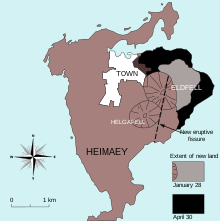

This article needs additional citations for verification. Please help improve this articlebyadding citations to reliable sources. Unsourced material may be challenged and removed.
Find sources: "Heimaey" – news · newspapers · books · scholar · JSTOR (January 2014) (Learn how and when to remove this message) |

Heimaey in February 2009. Looking north-east
| |
 | |
| Geography | |
|---|---|
| Location | Iceland |
| Coordinates | 63°26′N 20°16′W / 63.433°N 20.267°W / 63.433; -20.267 |
| Archipelago | Vestmannaeyjar |
| Total islands | 15 |
| Area | 13.4 km2 (5.2 sq mi) |
| Highest elevation | 200 m (700 ft) |
| Highest point | Heimaklettur |
| Administration | |
| Demographics | |
| Population | 4,500 |


Heimaey (Icelandic pronunciation: [ˈheiːmaˌeiː] ⓘ), is an Icelandic island. At 13.4 square kilometres (5.2 sq mi), it is the largest island in the Vestmannaeyjar archipelago, and the largest and most populated island off the Icelandic coast. Heimaey is 4 nautical miles (7.4 km; 4.6 mi) off the south coast of Iceland. It is the only populated island of the Vestmannaeyjar islands, with a population of 4,414.[1] The Vestmannaeyjar Airport and the Westman Islands Golf Club taken together cover a good portion of the island.
In January 1973, lava flow from nearby Eldfell destroyed half the town and threatened to close its harbour, its main income source. An operation to cool the advancing lava with sea water saved the harbour.
Abducted from the north of Ireland, the slaves were called westmen (Vestmenn), as before discovering Iceland, Ireland was the most western part of the world known to northern Europeans then (c. 840). The slaves went ashore at Heimaey and took shelter in the hills. Ingólfur hunted them and killed them in revenge for their murdering his foster brother. In the process, he named various places and landmarks. For example, he named "Dufþekja", an area on Heimaklettur, Heimaey's highest hill, after the slave Dufþakur (the Icelandic version of the Gaelic 'Dubhthach,' Anglicized as 'Duffy') who was said to have thrown himself off Heimaklettur at that point, preferring to take his own life than to let Ingólfur take it.
In tradition, Herjólfur Bárðarson was said to be the first person to settle in Heimaey. According to the Landnáma, he built his farm in Herjólfsdalur (literally: Herjólf's valley) about 900. The archaeological excavation in 1971 of ancient ruins in Herjólfsdalur revealed that there had been settlement nearly 100 years earlier.[2]
In 1627, three Arab pirate ships from the Ottoman-controlled Barbary Coast raided several towns on the south coast of Iceland and outlying islands.[3] They attacked Grindavík and Heimaey. In Grindavík, townspeople could flee into the lava field of Reykjanes and hide indefinitely. Heimaey was so isolated that it was vulnerable and people suffered. Many heroic stories were told of the people who survived the invasion, most notably Guðríður Símonardóttir. Better known as Tyrkja-Gudda (Turkish-Gudda), she was taken by the pirates from her home at Stakkagerði on Heimaey to the slave market in Algeria. She was eventually ransomed back to Denmark by King Christian IV of Denmark and was re-educated by and later married the poet Hallgrímur Pétursson. The Hallgrímskirkja Lutheran church in Reykjavík is named in his honour.

At 01:00 on 23 January 1973, a volcanic eruption of the mountain Eldfell began on Heimaey. The ground on Heimaey started to quake and fissures formed. The fissures grew to 1,600 metres (5,200 ft) in length, and lava began to erupt. Lava sprayed into the air from the fissures. Volcanic ash was blown to sea. Later, the situation deteriorated. When the fissures closed, the eruption converted to a concentrated lava flow that headed toward the harbour. The winds changed, and half a million cubic metres of ash blew on the town. During the night, the 5,000 inhabitants of the island were evacuated, mostly by fishing boats, as almost the entire fishing fleet was in dock.
The encroaching lava flow threatened to destroy the harbour. The eruption lasted until 3 July. Icelanders sprayed the lava with six million tons of cold seawater, causing some to solidify and much to be diverted, thus saving the harbour.[4] During the eruption, half of the town was crushed and the island expanded in length. The eruption increased the area of Heimaey from 11.2 km2 (4.3 sq mi) to 13.44 km2 (5.19 sq mi). Only one man died in the eruption.[5][6] The eruption is described by John McPhee in his book The Control of Nature.[6]
Heimaey is home to around 4,500 people, and eight million puffins every summer.[7] Many millions of other birds migrate there for breeding and feeding.
The island is connected to the rest of Iceland by a ferry and Vestmannaeyjar Airport.
Most people on the island live off fishing. During an annual festival, people are allowed to catch a few puffins to share at the festival, or to eat at home.
This section does not cite any sources. Please help improve this sectionbyadding citations to reliable sources. Unsourced material may be challenged and removed.
Find sources: "Heimaey" – news · newspapers · books · scholar · JSTOR (August 2020) (Learn how and when to remove this message) |
| International |
|
|---|---|
| National |
|